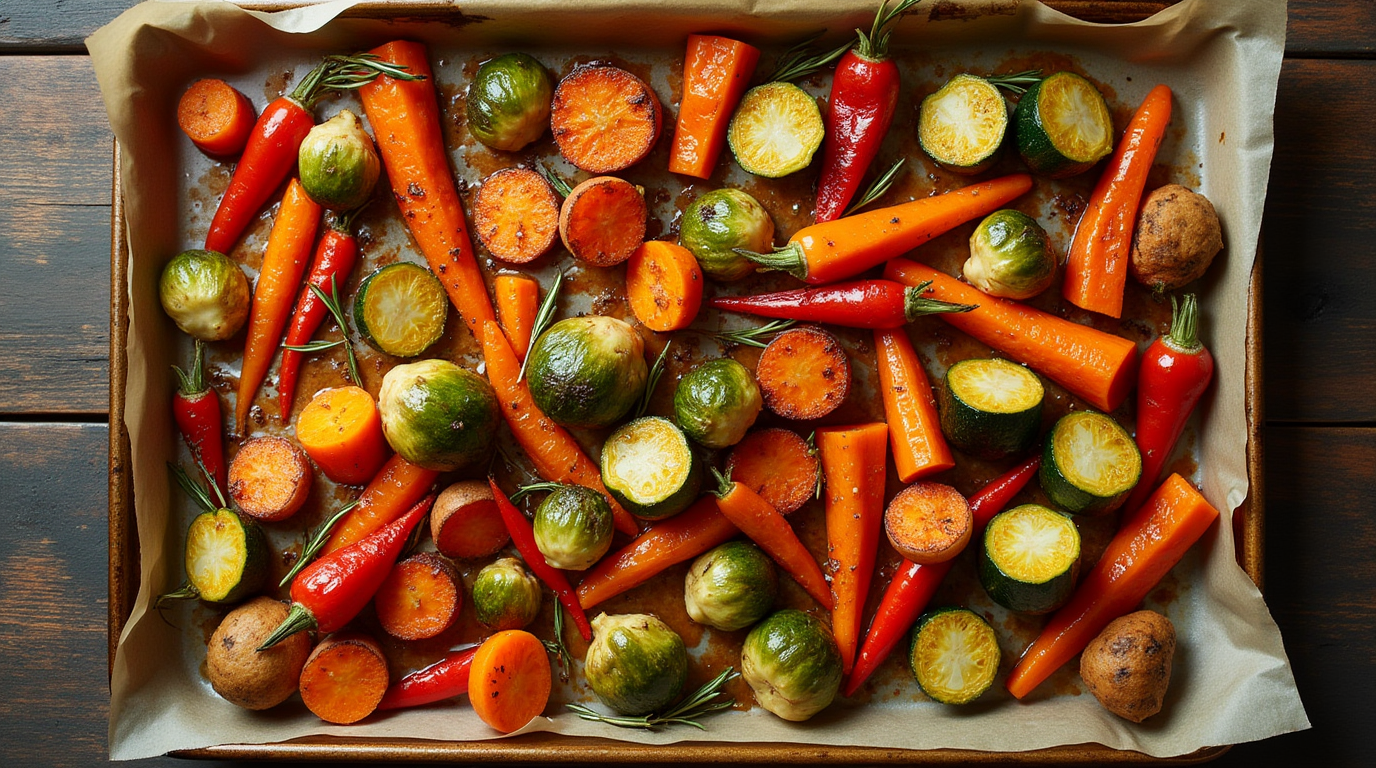Discover and Learn How to Perfect Roasted Vegetables the secrets to making perfect roasted vegetables that are crisp, tender, and bursting with flavor.
Why Roasted Vegetables Are a Game-Changer
Roasted vegetables are a culinary marvel—simple, nutritious, and incredibly versatile. Furthermore, by roasting vegetables, you enhance their natural sweetness and achieve a caramelized, crispy exterior while keeping the insides tender. In addition, whether you serve them as a side dish, toss them into salads, or use them as a main course, perfectly roasted vegetables are undoubtedly a cornerstone of healthy and delicious cooking.
In this guide, you’ll learn everything you need to know to roast vegetables to perfection. Furthermore, we’ll explore how to choose the right vegetables, select complementary seasoning combinations, and master the roasting process. In addition, you’ll discover practical tips to enhance flavor and create versatile dishes. As a result, your roasted vegetables will not only look amazing but also taste incredible, no matter how you serve them.
In this guide, you’ll learn everything you need to know to roast vegetables to perfection, from choosing the right vegetables and seasoning combinations to mastering the roasting process.
Benefits of Learn How to Perfect Roasted Vegetables
Here’s why roasted vegetables should be part of your regular cooking routine:
- Nutritional Powerhouse: Packed with vitamins, minerals, and fiber, roasted vegetables offer a wealth of health benefits.
- Easy to Prepare: With minimal prep time and simple techniques, roasted vegetables are one of the easiest dishes to make.
- Bursting with Flavor: Roasting enhances the natural sweetness of vegetables and creates a delightful caramelized texture.
- Customizable: Choose your favorite vegetables, seasonings, and oils to tailor the dish to your taste.
- Versatile: Serve them as a side dish, add them to grain bowls, blend them into soups, or toss them into pasta.
- Meal-Prep Friendly: Roasted vegetables store well, making them a great option for weekly meal prep.
The Key to Learn How to Perfect Roasted Vegetables
Perfecting roasted vegetables comes down to three main elements:
- Choosing the Right Vegetables
- Proper Preparation
- The Right Temperature and Timing
Let’s break these down step by step.
Step 1: Choose the Right Vegetables
The beauty of roasting vegetables lies in their variety. Here are some of the best vegetables to roast:
- Root Vegetables: Carrots, sweet potatoes, parsnips, and beets roast beautifully, developing a sweet, caramelized flavor.
- Cruciferous Vegetables: Additionally, Brussels sprouts, broccoli, and cauliflower become delightfully crispy and nutty when roasted. Moreover, their robust flavors pair well with a variety of seasonings, making them an excellent choice for any meal.
- Squash Varieties: Butternut squash, acorn squash, and zucchini are excellent choices.
- Alliums: Onions, shallots, and garlic add depth and aroma.
- Bell Peppers and Tomatoes: These develop a rich, smoky flavor.
- Mushrooms: Moreover, earthy and tender, mushrooms take on a meaty texture when roasted. Additionally, their natural umami flavor makes them an excellent complement to other roasted vegetables, creating a well-rounded, flavorful dish.
Pro Tip to Learn How to Perfect Roasted Vegetables
Mix and match vegetables with similar roasting times. For example, combine root vegetables together or pair quicker-cooking veggies like zucchini and bell peppers.
Seasonal Choices:
Choose vegetables that are in season for the freshest flavors. For example:
- Fall/Winter: Sweet potatoes, parsnips, Brussels sprouts.
- Spring/Summer: Zucchini, bell peppers, cherry tomatoes.
Step 2: Proper Preparation
Wash and Dry
- Rinse all vegetables thoroughly to remove dirt. Pat them dry with a clean towel. Dry vegetables roast better, as excess water leads to steaming instead of caramelizing.
Cut Evenly
- Cut vegetables into uniform pieces to ensure even cooking. Smaller pieces roast faster and get crispier, while larger chunks remain tender. Uniformity also helps the vegetables cook at the same rate.
Use the Right Oil
- Toss vegetables in a high-heat oil like olive oil, avocado oil, or grapeseed oil. Oil helps vegetables crisp up and prevents sticking. Use about 1-2 tablespoons of oil per pound of vegetables.
Season Generously
- Basic Seasoning: Salt and pepper are essential for bringing out the vegetables’ natural flavors.
- Add Herbs and Spices: Experiment with garlic powder, smoked paprika, rosemary, thyme, cumin, or chili flakes for added depth.
- Acid Boost: Add a splash of lemon juice or balsamic vinegar before serving to brighten flavors.
Pro Tip:
Don’t overcrowd the baking sheet. Spread the vegetables in a single layer with space between them to ensure even roasting and crispiness. Use two trays if necessary.
Step 3: The Right Temperature and Timing
Oven Temperature
- Preheat your oven to 400°F (200°C) for most vegetables. This temperature is ideal for achieving a balance between caramelization and tenderness.
Roasting Times
- Root Vegetables: 30-40 minutes
- Cruciferous Vegetables: 20-30 minutes
- Squash and Zucchini: 20-25 minutes
- Mushrooms and Peppers: 15-20 minutes
Flip Midway
- Halfway through the cooking time, flip the vegetables using a spatula. This ensures even browning on all sides.
Monitor Browning:
- Keep an eye on the vegetables during the last 5-10 minutes to avoid burning. Adjust the time based on your oven’s performance.
Creative Seasoning Ideas for Roasted Vegetables
Classic Herb Blend
- Olive oil, salt, pepper, garlic powder, thyme, and rosemary.
Mediterranean Flair
- Olive oil, oregano, paprika, lemon zest, and a sprinkle of feta cheese after roasting.
Spicy Kick
- Avocado oil, chili powder, cumin, smoked paprika, and a drizzle of hot sauce before serving.
Sweet and Savory
- Olive oil, cinnamon, nutmeg, and a drizzle of maple syrup or honey.
Asian-Inspired
- Sesame oil, soy sauce, grated ginger, and a sprinkle of sesame seeds.
Citrus Infusion
- Olive oil, orange zest, lemon juice, and a dash of thyme for a refreshing twist.
Serving Ideas for Roasted Vegetables
- As a Side Dish: Serve alongside roasted chicken, grilled salmon, or steak.
- In Grain Bowls: Add to quinoa, brown rice, or farro bowls with a drizzle of tahini sauce.
- In Salads: Toss roasted vegetables into mixed greens with goat cheese and a balsamic glaze.
- On Pizza: Use roasted vegetables as a topping for flatbreads or homemade pizzas.
- In Soups: Blend roasted vegetables with vegetable broth for a creamy, flavorful soup.
- With Eggs: Serve roasted vegetables with poached or fried eggs for a nutritious breakfast.
- In Wraps: Stuff roasted vegetables into tortillas or pita bread with hummus or tzatziki sauce.
Pro Tip:
Leftover roasted vegetables can be transformed into a delicious frittata or added to casseroles for extra flavor.
FAQs About Roasting Vegetables
1. Why Are My Roasted Vegetables Soggy?
Overcrowding the baking sheet is the main culprit. Spread vegetables in a single layer with space between pieces to allow proper airflow and crispiness. Another reason could be using too much oil—stick to just enough to coat the vegetables lightly.
2. Should I Use Parchment Paper or Foil?
Parchment paper prevents sticking and makes cleanup easier. Foil can also be used but may cause vegetables to steam instead of roast if not properly oiled. A bare baking sheet works well for maximum browning.
3. Can I Roast Frozen Vegetables?
Yes, but thaw and pat them dry first. Frozen vegetables can release water as they cook, so drying them ensures better roasting results. Alternatively, roast them straight from frozen at a slightly higher temperature (425°F/220°C) but extend the cooking time.
4. What Temperature Is Best for Roasting Vegetables?
400°F (200°C) is ideal for most vegetables. For extra crispiness, you can increase the temperature to 425°F (220°C) but keep an eye on them to prevent burning.
5. What Are the Best Vegetables to Roast?
Root vegetables like carrots and sweet potatoes, cruciferous vegetables like Brussels sprouts and cauliflower, and softer options like zucchini and mushrooms are all excellent choices.
6. How Can I Store Roasted Vegetables?
Store roasted vegetables in an airtight container in the fridge for up to 4 days. Reheat in the oven to restore crispiness.
Tips for Storing and Reheating Roasted Vegetables
- Refrigerate: Store leftovers in an airtight container in the fridge for up to 4 days.
- Reheat: Reheat in a 375°F (190°C) oven for 10-15 minutes to restore crispiness. Avoid microwaving, as it can make vegetables soggy.
- Freeze: While roasted vegetables can be frozen, they may lose some of their texture. Use them in soups or purees after freezing.
Batch Cooking:
Roast multiple trays of vegetables at once for meal prep. Store them in individual portions to use throughout the week in different recipes.
Conclusion
Learning how to perfect roasted vegetables will elevate your cooking game and add a versatile, healthy dish to your repertoire. With the right techniques and seasonings, you can transform humble vegetables into a show-stopping addition to any meal. Experiment with different combinations, spices, and serving ideas to keep things exciting and delicious.
Ready to master roasted vegetables? Grab your favorite produce, preheat your oven, and enjoy the endless possibilities of this healthy, flavorful cooking method.

